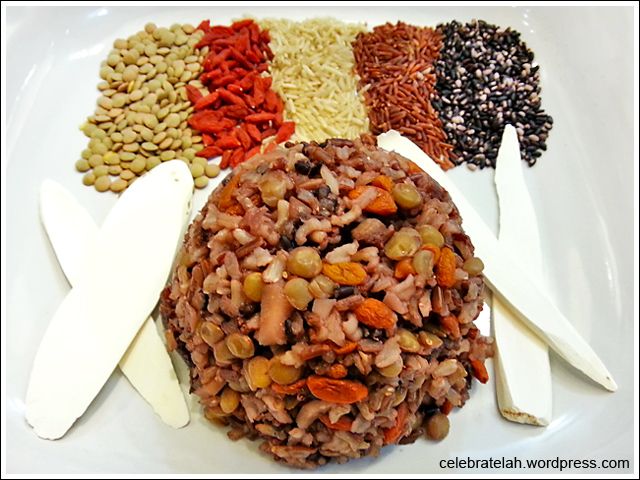Rice has the effect of garlic to vampires for any gym bunny trying to carve a 6-pack or those on a low-carb high protein diet to lose weight. I know, because I’m one of those carb adverse even though I love rice and the floury taste of banmian (板面).
So instead of giving up rice altogether, I’ve found an alternative to make the calories count with every mouthful by carbing on not white rice, but a mixture of grains and herbs to increase the nutritional value of my bowl.
Here’s an herbal rice blend I’ve experimented with that’s packed with more fibre, vitamins, minerals and higher protein content than regular white rice. And the added Chinese herbs have health promoting efficacies as well!

Ingredients for herbal rice : (left to right) Green Lentils (绿扁豆), Wolfberries (枸杞子), Brown Rice (糙米), Red Cargo Rice (红糙米), Black Rice (黑紫米), Dioscorea Opposita (淮山), and Angelica Sinensis (当归). Angelica Sinensis is not pictured here.
The ingredients sound exotic but they can all be found at local supermarkets in Singapore such as NTUC, Cold Storage, Giant and Sheng Siong with the exception of Black Rice which I bought from Mustafa Centre. If you can’t find the herbs at the supermarts, Chinese medicinal halls are bound to have them. The non-white rice varieties cost more than regular white grains with black rice being the most expensive (depending on brand, a 1kg pack of black rice costs around S$8 while white rice of the same weight costs between S$4 to S$6).
How to Cook : Simply wash all the grains and herbs and cook them together in a rice cooker. Cooking duration is approximately 30 minutes.
In terms of quantity, brown rice should form the bulk with red rice at half the amount used for brown and black rice at a quarter that used for brown. That is, if you used 40g of brown, then use 20g of red and 10g of black (use the same amount of lentils as black rice). But this is not cast in stone and you can vary the rice and lentils ratios according to preference.
For the herbs, use about a handful of wolfberries, 4 to 5 medium slices of dioscorea and 3 – 4 slices of angelica. Angelica has a very strong flavor so refrain from using too much or the resulting rice may taste bitter. Cut the dioscorea and angelica slices into tiny pieces to mix in better with the grains.
Once all the ingredients are in the rice cooker, add water. The water level should go slightly above the knuckles when you place your palm on the layer of rice and herbs. The more water you put, the softer the rice when cooked but too much and you will end up with a sticky rice mud.
Delicious and Healthy
The combination of nutty flavours from unpolished rice (brown and red) with the beany musk of lentils and aromatic fragrances of Chinese herbs gives the herbal rice a complex taste with a hint of bittersweetness.
You can Google each of the ingredients to read up on their health benefits but I would like to specially highlight the value of consuming black rice as more clinical research are uncovering the powerful antioxidant activity of this dark grain. Due to its scarcity, black rice was reserved and eaten only by emperors in ancient China, hence it is also known as the “Forbidden Rice”.
My first encounter with black rice was during a trip to the Yaeyama Islands, a group of islets off Okinawa, Japan. Residents on the Okinawan islands consume black rice and small bittergourd on a daily basis and the area has the highest number of centurions in the world. Many other factors definitely contribute to longevity but the Okinawans’ unique diet of black rice may be one of the key contributing ingredients.
Already, some health sites are calling black rice the new super food as it contains more vitamin E than brown rice and has higher anthocyanin content than blueberries, bestowing it with super antioxidant prowess that could potentially guard against a myriad of cardiovascular diseases, cancers and age-related conditions.
So the next time you have a carb crave, go black and don’t go back!
Tagged: Diet, fitness, Food, Health, Recipes, Weight Loss
